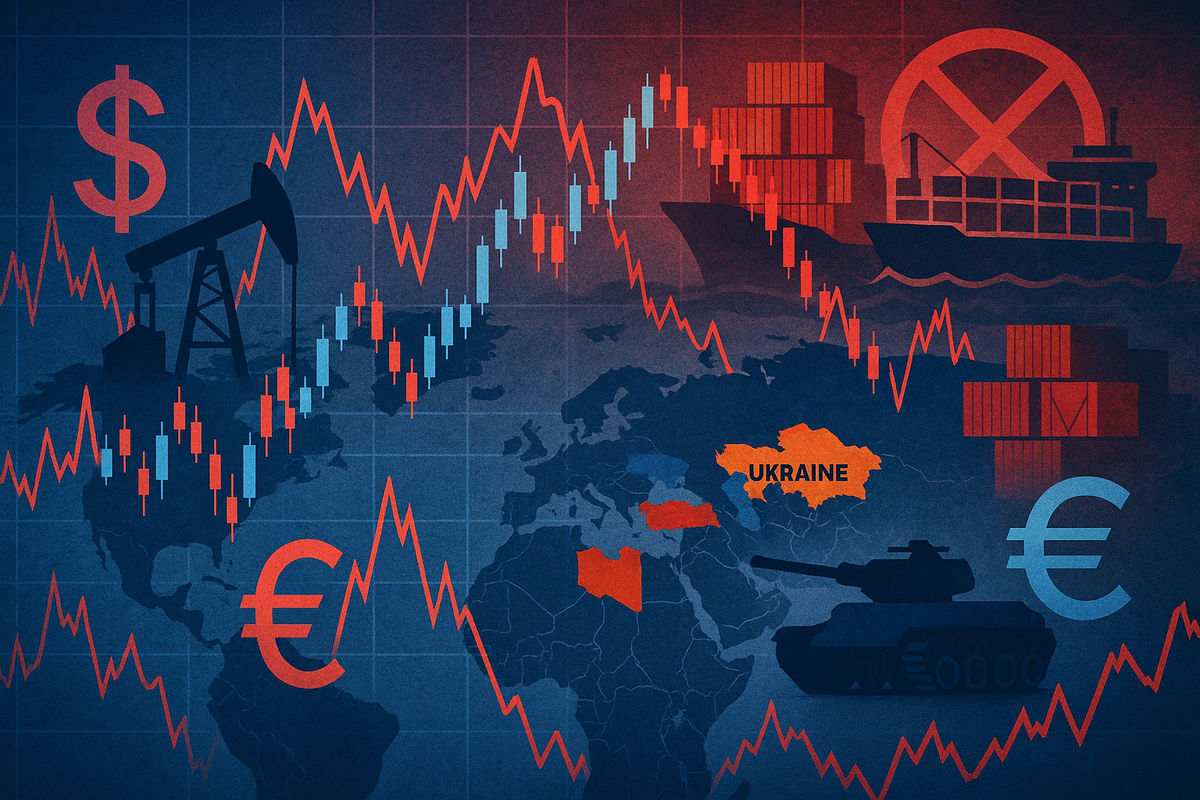
The global financial landscape is currently experiencing significant turbulence, driven by a confluence of geopolitical conflicts and aggressive new trade policies. Ongoing tensions in the Middle East and the protracted conflict in Ukraine are sending ripples through the energy and defense sectors, while the recent introduction of sweeping U.S. tariff policies has unleashed widespread market volatility, wiping out trillions in market value and reshaping investor sentiment.
These intertwined events are creating a complex and unpredictable environment for businesses and investors alike. The immediate implications include surging oil prices, a boom in defense stocks, and a palpable sense of uncertainty that is causing major market indexes to fluctuate wildly. As nations grapple with these challenges, the global economy faces material headwinds, forcing a re-evaluation of supply chains, investment strategies, and international trade relations.
A World on Edge: Conflicts and Tariffs Reshape Market Dynamics
The current market upheaval is largely attributable to two major forces: escalating geopolitical conflicts and the strategic deployment of new tariff policies by the United States. Each of these elements, while distinct, contributes to a broader narrative of uncertainty and re-calibration within the global financial system.
The Middle East, a perennial flashpoint, continues to exert significant influence over global energy markets. Recent escalations, including the Israel-Hamas war and heightened tensions between Israel and Iran, have injected a substantial "geopolitical premium" into oil prices. Fears of supply disruptions, particularly through critical chokepoints like the Strait of Hormuz, have caused crude oil benchmarks to surge. For instance, reports of U.S. military actions or Israeli strikes in the region have consistently led to immediate spikes in oil prices, directly impacting energy companies and consumer costs. Simultaneously, the ongoing conflict in Ukraine, stemming from Russia's invasion in early 2022, continues to destabilize global energy supplies. Russia, a major global petroleum exporter, has seen its energy exports become a geopolitical tool, with sanctions and retaliatory measures causing significant price volatility. Ukrainian drone strikes on Russian oil infrastructure further exacerbate these tensions, underscoring the fragility of the global energy supply chain.
In parallel, the introduction of new U.S. tariff policies has sent shockwaves through international trade and financial markets. These tariffs, often aimed at specific countries or industries, are designed to protect domestic industries but have far-reaching consequences. The initial announcement of sweeping new tariffs in early April 2025, for example, triggered a dramatic market downturn, with the S&P 500 (NYSEARCA: SPY) falling below 5,000 points for the first time in nearly a year, resulting in the loss of trillions of dollars in market capitalization. The Dow Jones Industrial Average (NYSEARCA: DIA), S&P 500, and Nasdaq Composite (NASDAQ: QQQ) have all experienced significant declines following these policy shifts. The rationale behind these tariffs often involves national security concerns, economic leverage, or a desire to rebalance trade deficits. However, they invariably lead to higher input costs for U.S. companies, which can erode profit margins or be passed on to consumers, fueling inflationary pressures. Moreover, these tariffs frequently provoke retaliatory measures from affected trading partners, further disrupting global supply chains and making U.S. exports less competitive on the international stage. The unpredictability of these trade policies has forced investors to re-evaluate their strategies, often leading to a shift towards more defensive assets and increased market volatility, as evidenced by spikes in the VIX index, a key measure of market fear.
The Shifting Sands: Winners and Losers in a Volatile Market
The current geopolitical and trade landscape is creating distinct winners and losers across various sectors of the stock market. Companies with direct exposure to the affected industries are experiencing significant shifts in their valuations and operational outlooks.
On the winning side, defense contractors are undoubtedly benefiting from heightened global tensions. As conflicts in the Middle East persist and the war in Ukraine continues to fuel international demand for military hardware, defense stocks are soaring. Companies like Lockheed Martin (NYSE: LMT), RTX (NYSE: RTX) (formerly Raytheon), Northrop Grumman (NYSE: NOC), and L3Harris Technologies (NYSE: LHX) have seen their stock prices climb to record highs. This surge is driven by expectations of expanded military budgets globally, increased defense contracts, and a consistent long-term demand as nations prioritize enhancing their defensive and offensive capabilities. The Russia-Ukraine war, in particular, has spurred a significant increase in defense spending across NATO and other allied nations, directly translating into robust order books and strong financial performance for these companies. Investors are increasingly viewing these firms as safe havens during periods of geopolitical instability, leading to their outperformance against broader market indexes.
Conversely, many sectors are feeling the pinch of rising oil prices and new tariff policies. Industries heavily reliant on global supply chains and international trade are particularly vulnerable. Companies that import significant raw materials or components subject to new tariffs face increased input costs, which can compress profit margins or necessitate price increases for consumers. This directly impacts consumer discretionary sectors, manufacturing, and technology companies that have extensive global supply chains. Furthermore, U.S. exporters are suffering from retaliatory tariffs imposed by trading partners, making their products more expensive and less competitive in key international markets. This can lead to reduced sales volumes and market share losses for companies in agriculture, automotive, and various manufacturing sectors. The uncertainty surrounding trade policy also deters foreign direct investment and can lead to a slowdown in global economic growth, impacting a wide array of companies that thrive in a stable and open international trade environment.
Broader Implications: Reshaping Industries and Global Commerce
The current confluence of geopolitical events and tariff policies extends far beyond immediate market fluctuations, signaling a fundamental reshaping of industry trends, global supply chains, and regulatory frameworks. This period of instability is forcing a re-evaluation of long-held assumptions about globalization and interconnectedness.
One of the most significant broader implications is the acceleration of supply chain diversification and regionalization. Companies that once prioritized cost efficiency through highly centralized global supply chains are now actively seeking to de-risk by diversifying their sourcing and manufacturing locations. The disruptions caused by conflicts and tariffs have highlighted the vulnerabilities of relying on single points of failure or politically sensitive regions. This trend could lead to increased investment in domestic manufacturing capabilities and the development of more resilient, albeit potentially more expensive, regional supply networks. This shift will have ripple effects on logistics, infrastructure development, and labor markets globally.
Furthermore, the aggressive use of tariffs by the U.S. is prompting a re-evaluation of international trade agreements and regulatory frameworks. The World Trade Organization (WTO), designed to facilitate free and fair trade, is facing increasing challenges to its authority as nations prioritize national interests over multilateral cooperation. This could lead to a more fragmented global trading system, characterized by bilateral agreements and regional blocs, rather than a unified global market. Historically, periods of increased protectionism have often preceded economic downturns or trade wars, as seen in the 1930s. While the current situation is not a direct parallel, the parallels in policy direction are concerning and could lead to prolonged economic headwinds. Competitors and partners alike are being forced to adapt, with some nations seeking new trade alliances and others implementing their own protectionist measures in response.
What Comes Next: Navigating the Uncharted Waters
The path forward for the global markets, under the shadow of ongoing geopolitical tensions and evolving trade policies, remains highly uncertain. Both short-term volatility and long-term structural shifts are anticipated, requiring strategic pivots from businesses and investors alike.
In the short term, markets are likely to remain highly sensitive to news flow from the Middle East and Ukraine. Any significant escalation or de-escalation of conflicts will directly impact oil prices and defense stock valuations. Similarly, further announcements regarding new tariffs or retaliatory measures will continue to trigger immediate market reactions. Investors should brace for continued volatility, with sharp swings in major indexes becoming a more frequent occurrence. Companies will need to focus on agile supply chain management and robust risk assessment to mitigate the immediate impacts of these external shocks.
Looking further ahead, the long-term implications suggest a more fragmented and regionalized global economy. The push for supply chain resilience and national security considerations will likely outweigh pure cost optimization for many businesses. This could lead to increased domestic investment in key industries, potentially fostering job growth in some regions while impacting others that have historically relied on globalized manufacturing. New market opportunities may emerge in areas like cybersecurity, advanced materials, and localized production technologies as companies seek to build more secure and self-sufficient operations. However, challenges such as higher production costs, reduced economies of scale, and potential trade barriers will also need to be navigated. Investors should consider diversifying their portfolios to include companies that are well-positioned to benefit from these shifts, such as those involved in automation, domestic infrastructure, and renewable energy, which could gain traction as nations seek energy independence.
Conclusion: A New Era of Market Dynamics
The current period of geopolitical instability and aggressive tariff policies marks a significant inflection point for global financial markets. The immediate impacts—surging oil prices, booming defense stocks, and widespread market volatility—are clear indicators of a system under immense pressure. However, the lasting legacy of these events will likely be a fundamental re-shaping of global trade, supply chains, and investment strategies.
The key takeaway for investors and businesses is the imperative of adaptability and resilience. The era of seamless globalization, driven primarily by cost efficiency, appears to be giving way to a more complex landscape where geopolitical risk and national security considerations play an increasingly dominant role. Companies that can successfully diversify their supply chains, innovate to reduce reliance on volatile regions, and navigate complex regulatory environments will be best positioned for success.
Moving forward, investors should closely monitor developments in key geopolitical hotspots and track the evolution of international trade policies. The interplay between these forces will continue to dictate market sentiment and sector performance. While the immediate future promises continued turbulence, it also presents opportunities for those who can identify and capitalize on the emerging trends of a more regionalized, resilient, and strategically focused global economy. The coming months will be crucial in determining the long-term trajectory of these profound shifts.



